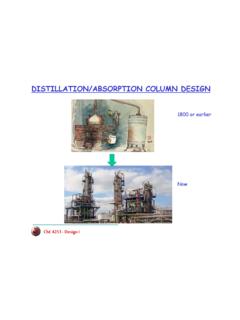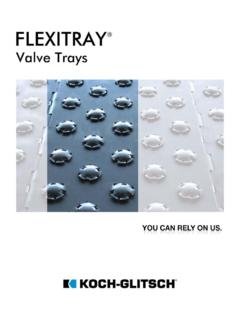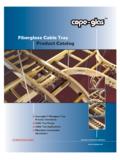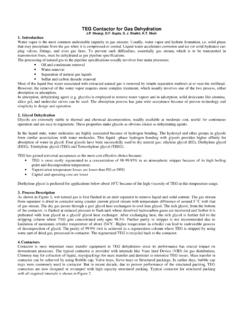Transcription of CRYOGENIC CONSULTING SERVICE , INC.
1 CRYOGENIC CONSULTING SERVICE , argon PRODUCTIONA Technology Review Paper for Presentation at the 1999 Modern Air Separation Plant Technology ConferenceJuly 26 -- 27, 1999 at Chengdu, People's Republic of ChinaBy Joseph T. Bernstein, CRYOGENIC CONSULTING SERVICE Separation BackgroundThe major components of atmospheric air include nitrogen ( ), oxygen ( )and argon ( ). argon is produced as a byproduct of CRYOGENIC air separation forthe production of pure oxygen or pure oxygen and on whether product oxygen and nitrogen are low pressure gas or high-pressure gas or liquids, CRYOGENIC air separation processes may take various Low Pressure Cycle (Figure 1) utilizes air compressed to approximately 6 atma;heat exchange to cool air to near condensing temperature (utilizing cooling from productoxygen, nitrogen, etc.)
2 And distillation Towers to separate air into pure oxygen the "Split Cycle" process shown in Figure 2, some air is compressed to a higherpressure to allow liquid oxygen to be pumped to a product pressure and evaporated inthe product -- air exchanger. Many other process variations exist, but all ASU cryogenicsystems include: air compressor or compressors means of removing the freezable impurities, water and CO2 means of producing low temperature refrigeration (expander) feed -- product heat exchangers distillation TowersThe various approaches to air separation will be discussed in other conference this presentation, we will focus on the elements, which relate to argon separation of air into oxygen and nitrogen almost always utilizes the "double tower"system (Figure 3) in which air is first separated into a pure nitrogen liquid and anenriched oxygen liquid (35% -- 39% oxygen)
3 In a "high-pressure" column at about 6atma. The liquid N2 produced in the "high-pressure" tower solves a problem ofproviding liquid nitrogen reflux at the top of the upper (low pressure) tower, whichaccomplishes the final separation into oxygen and nitrogen products at about 29, 2004 Page 2 The double tower system utilizes liquid oxygen at the bottom of the low pressure towerto condense nitrogen gas at the top of the high-pressure column. The pressure of theboiling liquid oxygen at the bottom of the low pressure tower determines its boilingtemperature, which in turn determines the condensing temperature and pressure for thenitrogen vapor at the top of the high-pressure temperature and pressure relationships of the double tower system are shownin Table 1.
4 Two cases are shown in Table 1, a plant utilizing trays (usually sieve trays)and not employing techniques for minimizing temperature differences or pressure dropis shown on the left, and a plant utilizing packing for the "low pressure" column, andother techniques for minimizing pressure and temperature differences is shown on theright side. The high-pressure drop or low pressure drop design may reflect differenteconomic conditions such as power cost and plant size. In general, very large plantsmake low pressure drop economically pressure at the bottom of the low pressure tower results from the pressure dropthrough the low pressure tower itself and the feed -- product heat exchangers and otherequipment until the "waste" nitrogen is vented to atmospheric pressure.
5 The result is arequirement for air entering the high-pressure column to be at a pressure of about 5 or low pressure tower functions mainly to produce oxygen product and nitrogenproduct and/or waste nitrogen, but since argon has a boiling temperature between thatof oxygen and nitrogen (see Figure 4, oxygen, nitrogen & argon vapor pressure) therewill be a significant build-up of argon in the low pressure tower (as long as oxygen isproduced as a relatively pure product). Figure 5 shows a typical concentration profilefor oxygen, nitrogen and argon vapor within a low pressure tower producing pureoxygen.
6 Figure 5 shows that although argon is less than 1% of the air composition, itmay build up to 10% or even 20% in the trays in the middle of the low pressure tower(below the enriched air feed point). The extent of the build-up of argon is determined bythe purity of the oxygen and nitrogen products, and by the number of distillation stagesand rates in the low pressure ProductionThe production of argon involves connecting a "side arm" column, which receives a feedvapor from the low pressure column at a point near the maximum argon concentration,but also at a point where nitrogen concentration is still low.
7 The typical argon "side arm"column connected to a double tower system is shown in Figure side arm column utilizes condensing provided by partially evaporating theapproximate 38% oxygen liquid "enriched air" feed to the low pressure column. Figure6 shows typical temperature and pressures in the low pressure tower and argon sidearm tower. The pressure at the top of the argon side arm (crude argon ) tower has alower limit of about atma or 29, 2004 Page 3 This lower limit is set by two factors:a.) the available temperature for condensing which is set by the pressure andcomposition of the evaporating "enriched air" liquid, as determined by the conditionsof the double tower ) the fact that the "crude argon " product from the top of the side arm column should bedelivered at a pressure slightly above atmospheric pressure after warming toambient temperature in a heat of these factors limit the minimum pressure at the top of the crude argon side armcolumn to about atma (or at the extreme atma).
8 Therefore, as shown in Figure 6, the maximum available pressure difference from thebottom to the top of the argon side arm column is about atma. Utilizing distillationtrays with a pressure drop equivalent to about 4 cm of liquid ( atma)the maximum number of trays in the crude argon tower is atma/.005 atma = 70trays. In typical practice, the tray type of crude argon side arm column will have 40 -- 60distillation the relative volatility of argon in argon -- oxygen mixtures is low (see Figure 7),the typical traditional argon side arm column (with 40 -- 60 trays) will produce a "crudeargon" product containing about 1% -- oxygen, as well as some nitrogen.
9 In orderto remove all oxygen (to 1 ppm or less) about 150 -- 200 stages would be required inthe argon side arm 7 allows us to understand the Liquid and Vapor flows within the crude argoncolumn. In Figure 7, = and V. -L. is the crude argon product quantity. Figure7 shows that, for an argon -- oxygen feed mixture containing about 12% to 16% argon ,the ratio must be at least about , or slightly higher. Assuming (V. -L.) =.008 ( argon in unit of air), and solving the two equations, V. = or 20%of the air feed for the assumed and V. -L. (.008 argon product is assomed formathematical simplicity, but typical argon recovery in a large, modern ASU may exceed95%.)
10 Of course, the exact L. and V. rates may vary slightly, but Figure 7 illustrates thatthe argon -- oxygen equilibrium does not allow for much variability of the ratio inthe crude argon side arm column. For instance, if = , by the samemathematical relationships, V. = 40%. The increase of from to wouldhave only a small effect in reducing the number of stages required, since isalready close to However, this increase of to would double the amount ofvapor flow in the crude argon column and double the condensing requirement at the topof the crude argon column.




